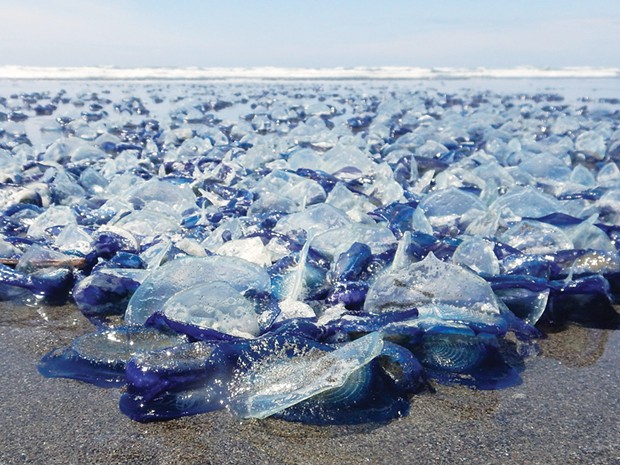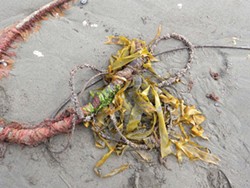Family-friendly Fionas
[
{
"name": "Top Stories Video Pair",
"insertPoint": "7",
"component": "17087298",
"parentWrapperClass": "fdn-ads-inline-content-block",
"requiredCountToDisplay": "1"
}
]
A bewildered-looking clown walked onto the stage, so I said, "Please welcome marine biology clown Max Winkle to Washed Up Family Science Hour!"
"Today we'll be learning about a sea slug called Fiona (Fiona pinnata), that lives only on floating objects out at sea. And it sometimes washes up on our local beaches riding those objects. Can you twist a sea slug balloon animal, Max? Or maybe tell a sea slug joke ...?"
Max whispered in my ear, "Sorry, Mike. My agent didn't mention actual marine biology clowning. But, maybe I could recite a funny line from my latest film? OK, ahem .... Hello, ladies. Here's your pizza. It's sausage."
The kids in the audience cheered like crazy for pizza. The parents didn't. So, I said, "That's right, Max, we humans love to eat pizza! But Fiona prefers to eat goose barnacles. In fact, most individual Fionas eat nothing else. Its diet is very specialized."
Max said, "In my business you can't be so specialized. You have to do all your own stunts, as it were."
"Sure, Max. But while Fiona's diet is restricted, it's a cosmopolitan species that lives on all the world's oceans in warm water and cold. Its larvae settle on almost any floating object, including driftwood, fishing floats, rafts of kelp and even floating, jelly-like animals such as by-the-wind sailors. And not coincidentally, the solid objects are the same habitat Fiona's prey barnacles settle on. Fiona attacks the barnacles using a toothed tongue, called a "radula," which easily rasps through the goose barnacle's fleshy stalk to access the tissues within."
"That sounds uncomfortable, Mike."
"I bet. Now, Fiona belongs to a class of sea slugs called nudibranchs, which have their respiratory organs exposed on their backs rather than under a protective mantle like most mollusks. In fact, 'nudibranch' means 'naked gill.'"
"I once did a mermaid-themed film called Naked Gills," said Max. "Unfortunately, mermaids are open-water broadcast spawners. But I adapted my techniques to theirs. I had to hold my breath longer than usual, but critics called my work 'genius' and 'revolutionary.'"
"Good for you, Max. If you look at a Fiona, in addition to oral tentacle feelers and its chemosensory antennae called 'rhinophores,' you'll notice two shaggy rows of banana-like projections. These are called 'cerata,' and in Fiona they are effectively its naked gills. Each cerata has a little flappy ridge along it. Fiona is the only known nudibranch with these flaps, which may provide added surface for enhanced organ function."
"Dang, Mike. If you chopped up that last paragraph, you could name like seven movies I was in," he said.
"These cerata also contain branches of the digestive tract. Barnacle-eating Fionas are normally brown or tan. But ones that settle on blue by-the-winds sailors develop beautiful blue cerata as they feed on them. I've never found any of those yet, but I'll keep looking!"
"You have a strange way of making a living, Mike."
"Sure. Now, Fionas don't get much longer than an inch, but they grow and reproduce faster than almost all other sea slugs. So, if a few larvae get lucky and settle on something floating and covered in goose barnacles, the population can explode to many thousands of slugs in order to take advantage of the bounty before it washes up somewhere. Anyway, that's the show, folks. Don't forget to look for washed-up Fionas!"
After the studio audience exited, I said, "Sorry about that, Max, but you arrived too early. I had to improvise. Now relax while the crew changes the set, and I'll call in the naughty marine biology grad students."
Biologist Mike Kelly (he/him) is also the author of the book Tigerfish: Traditional and Sport Fishing on the Niger River, Mali, West Africa. It's available at Amazon or everywhere e-books are sold.

































